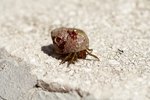Spiny king crabs (Neolithodes grimaldii) have many attributes that set them apart from other species. They look different, plus they have many adaptations that help them survive in their preferred ocean environment. From their lineage to their habitat, spiny king crabs are extremely interesting crustaceans.
General Information
Spiny king crabs are invertebrates and members of the king crab family. As spines cover the tops of their bodies, spiny king crabs are also called porcupine crabs. These spines not only distinguish them from other species of crab but offer porcupine crabs protection from potential predators. They have three pairs of legs each, along with a set of larger claws they use for hunting. A fourth, smaller pair of legs is located underneath each spiny king crab's body and is used exclusively to clean the gills.
Habitat
Spiny king crabs are a deep-water species, found at various depths greater than 200 feet. Some have been found on the ocean floor 2,400 feet down. Found on both sides of the Atlantic, spiny king crabs are often located near the continental slope. Most species of king crab prefer warmer waters, though they can survive varied temperatures.
Diet
Porcupine crabs are carnivorous. They prefer to hunt live prey but will settle for the remains of other sea creatures when necessary. Common food sources include other crabs, sea stars and small fish. They hunt using their large claws -- their right ones, which are always larger than their left claws -- and then their mouths to rip their prey apart. Although the spines protect them from many predators, a few natural predators like humans and octopus are concerns.
Bodily Details
Spiny king crabs are almost always red or pink, though some blue king crab species exist. Adult spiny king crab bodies average about 7 inches in length, each leg measures about 23 inches. Males are typically slightly larger than females. Both sexes have gills that give the crabs the ability to breathe under water via gas exchange facilitated by the under-body set of small legs.
Breeding and Life Span
Spiny king crabs live long lives -- some have reached 30 years of age. They are solitary, seeking each other out only during breeding season. They rely on the environment to find each other and mate. The females brood eggs that the males fertilize by directly placing sperm into the oviduct. When they hatch, they resemble miniature versions of adults. These young are called zoea.
More Facts
Porcupine crabs are one of 40 species of king crab, all of which are descendants of the hermit crab. They grow to be much larger than their ancestors, even though they still bear some resemblance. Higher numbers of these crabs are found as water depth increases. Even with large populations, there is no shortage of food to be had; when live prey are scarce, remnants of other kills are always available. Despite the fact that they live so deep underwater, they are at risk of becoming caught in the traps that humans harvest year-round. .
References
- Monterey Bay Aquarium: Spiny King Crab
- Encyclopedia of Life: Facts About Spiny King Crabs
- Memorial University Department of Ocean Sciences: Spiny Crab
- A-Z Animals: King Crab
- Science Direct: Characteristics of Bycatch of Porcupine Crabs
- Deep Sea Creatures of the North Atlantic: Neolithodes Grimaldii (Porcupine Crab)





